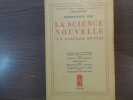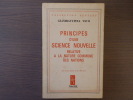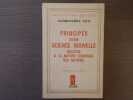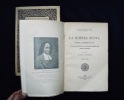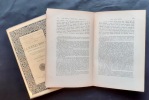30 books for « vico giambattista »Edit
-
Century
18th (1)
19th (2)
20th (11)
21st (2)
-
Countries
Belgium (2)
Denmark (2)
France (23)
Italy (1)
Switzerland (2)
-
Syndicate
ILAB (11)
SLAM (8)
Cinque orazioni latine inedite. Pubblicato da un Cod. MS. della Bibliotheca Nazionale per cura del bibliotecario Antonio Galasso. Con un discorso preliminare. - [THE FORERUNNER OF THE ""SCIENZA NUOVA""]
Napoli, Domenico and Antonio Morano, 1869. 8vo. Bound uncut and unopened with the original blue printed wrappers in a recent green full cloth binding with gilt leather title-label to spine. Back wrapper with worm holes, lack of lower corner, and tears.Some minor brownspotting due to the paper quality. CXXIII, (1), 72 pp.
The very rare first edition, first printing, of five of Vico's early orations (Oration I, III, IV, V, VI, and the beginning of II), which founded the first basis for his seminal ""Scienza Nuova"". The publication of the orations is based on manuscript XIII B 53 in the National Library of Naples. Although Vico's orations are of the greatest importance to the understanding of the philosophical and intellectual development of this seminal and vastly influential thinker, Vico himself only promoted the immediate publication of the last of them, namely the ""De nostri Temporis Studiorum Ratione"", which was printed in 1708, based on the argument that it summed up much of that which was included in his earlier orations. Thus, had it not been for Galasso, the invaluable five early orations, being all of the unpublished early texts, might not have been preserved for posterity. Besides this invaluable contribution to Vico scolarship, Galasso here also provides us with a very elaborate study on the seminal importance of the present orations. (Part of the second oration was published by Villarosa in 1823).GIAMBATTISTA VICO (1668 - 1744) was appointed professor of Latin Eloqence at the University of Naples in 1699 and possessed this chair till 1708. In this capacity Vico had to each year give an inaugural oration, and it is five of these that are printed here for the first time. Vico's orations were based on classic humanistic grounds, with great inspiration found in e.g. Pico della Mirandola, and he tried to urge his students to develop both as human beings and as scholars, inspiring them to use their education to become better persons, as well as inspiring them to keep educating themselves and persuading them that they have the capacity to become wise, telling them that they are ""born for wisdom"". As such, Vico's early orations display the greatest examples of his ideas of paideia and and humanitas as well as his inspiration from Greek and Latin sources and especially from the Renaissance humanists"" they contain the very first sketches of his theories on humanity and history, which later came to provide the basis for his revolutionary ""Scienza Nuova"".
LA SCIENCE NOUVELLE. Traduite par l'auteur de l'Essai sur la formation du dogme catholique
Paris Librairie Jules Renouard, et à la Librairie Charpentier 1844 in 12 (18x12) 1 volume reliure demi chagrin vert de l'époque, dos à nerfs, CXX, 4 feuillet non chiffrés de tableau chronologique dressé sur les trois époques des temps des Egyptiens, qui pensaient que le monde se divisait en trois âges : des dieux, des héros et des hommes, et 398 pages [1], rousseurs éparses. Giambattista Vico, 1668-1744. Edition orginale de la traduction. Bon exemplaire ( Photographies sur demande / We can send pictures of this book on simple request )
Bon Reliure
Vici Vindiciae + Vie de Giambattista Vico écrite par lui-même
Allia 2004 in12. 2004. Broché. 2 volume(s).
couvertures défraîchies notes sur les dernières pages quelques notes dans "Vie de Gimabattista"
The New Science of Giambattista Vico revised translation of the third edition 1744
Cornell university press 1975 488 pages 15 24x15 24x0 381cm. 1975. Cartonné. 488 pages.
Bon Etat couverture un peu frottée intérieur propre
Principi di scienza nuova
Milan, Giovanni Silvestri, 1816. In-8, IV-210-282-158 pp. 3 pl., demi-basane havane, coins de vélin ivoire, dos long orné de filets dorés, tranches mouchetées (épidermures, frottements et accidents à la reliure, rares rousseurs et taches).
Nouvelle édition italienne du plus célèbre ouvrage de l'épistémologiste et historien Giambattista Vico. Elle est illustrée d'un portrait de l'auteur, d'une planche allégorique et d'un tableau chronologique. Complet du catalogue de l'imprimeur. * Membre du SLAM et de la LILA / ILAB Member. La librairie est ouverte du lundi au vendredi de 14h à 19h. Merci de nous prévenir avant de passer,certains de nos livres étant entreposés dans une réserve.
Vico Giambattista Henri Catherine Henry Annie Schefer Jean-Louis
Reference : DZG42BR
ISBN : B0000ECR7I
Origine de la poésie et du droit (Collection dirigée par Jean-Louis Schefer et Philippe Blon)
Café Clima Broché D'occasion état correct 01/01/1983 414 pages
La filosofia di Giambattista Vico. Parte prima: Gnoseologia ed Estetica. Collana Scolastica di Testi Filosofici.
Firenze, G. C. Sansoni 1950, 200x130mm, 200pagine, in brossura. Buono stato. Pagine in parte non tagliate.
Pour un paiement via PayPal, veuillez nous en faire la demande et nous vous enverrons une facture PayPal
VIE DE GIAMBATTISTA VICO ECRITE PAR LUI MEME.
GRASSET.. 1981. In-8. Broché. Bon état, Couv. légèrement passée, Dos fané, Intérieur frais. 288 pages. Couverture souple illustrée. Un des ouvrages a des mouillures sur le deuxième plat de couverture.. . . . Classification Dewey : 920-Biographie générale et généalogie
Classification Dewey : 920-Biographie générale et généalogie
Oeuvres choisies de Vico contenant ses mémoires écrits par lui-même, la science nouvelle, les opuscules, lettres, etc., précédées d'une introduction sur sa vie et ses ouvrages par m. Michelet [3 tomes]
Bruxelles, Hauman, Cattoir et comp. (t.2-3: Meline, Cans et comp.) 1837-1840 Complet en trois tomes, reliés en 1 volume ; vii,230 + 277 + 268pp., 16cm., reliure cart., plats marbrés, dos en cuir brun avec titre et faux-nerfs dorés, qqs. rousseurs, bon état, F95208
AFFETTI DI UN DISPERATO.
Canzone riprodotta dalla stampa originale del 1693, con proemio di Benedetto Croce. Philobiblon, Napoli, 1948. In-8, mz. pergamena edit., marchio dell'editore (disegnato da Bruno Bramanti) in oro al piatto anter., astuccio, pp. 21 (proemio di Croce), (3),12 di facsimile (prima edizione della canzone). Unito un foglio volante con la riproduzione in nero dello stesso disegno impresso in oro al piatto, di Claudio Bonacini, ricavato dall'emblema dell'Accademia napoletana degli Uniti alla quale Vico venne aggregato nel 1692 con il titolo di Raccolto.Cfr. Cat. Mardersteig,83. Impressa per Costantino del Franco (e pubblicata a Napoli da Philobiblon), l'edizione fu tirata in 200 esempl. numerati, su carta a tino di Fabriano; la stampa fu eseguita a Verona col torchio dell'Officina Bodoni di Giovanni Mardersteig. Il ns., n. 53, è in ottimo stato.
Principj di scienza nuova. d'intorno alla comune natura delle nazioni. Colla vita dell'autore scritta da lui medesimo
Milan, Tipografia de' classici Italiani, 1801 3 tomes en un fort vol. in-8, LXXIV-152-293-[3]-165-[3] pp., avec un tableau dépliant hors-texte, manquent le portrait et la planche, demi-veau havane, dos lisse cloisonné et orné en long, pièce de titre noire, tranches marbrées (rel. du milieu du XIXe s.). Dos intégralement insolé, rousseurs.
Première édition posthume de l'oeuvre majeure de Vico (1668-1744), parue originellement en 1725, et qui n'avait été rééditée que deux fois du vivant de l'auteur, dont en 1744. Elle avait en effet été profondément oubliée ensuite. C'est la première à présenter l'autobiographie du philosophe. L'ouvrage est capital pour la prise de conscience historiciste de l'Occident, et il ne saurait être question de le résumer, d'autant que son foisonnement rend l'entreprise malaisée. Qu'il suffise de rappeler qu'il a influencé, à travers sa relecture, toute la pensée positive du XIXe siècle, et que, exempt des illusions du "progrès" nécessaire et indéfini qui fut la grande idole de la pensée des Lumières, il est susceptible de jeter une lumière neuve sur l'évolution historique même à l'époque de Fukuyama.Printing and the mind of man, 184 (pour l'originale). Cf. Croce (Benedetto) : Bibliografia Vichiana (Naples, 1947-1950). - - VENTE PAR CORRESPONDANCE UNIQUEMENT
Origine de la poésie et du droit
Café Clima;1983.In-8,coun.à rabats ill.414 p.Eat neuf malgré petites salissures sur la couv.
ORIGINE DE LA POESIE ET DU DROIT
ALLIA EDITIONS
LIVRE A L’ETAT DE NEUF. EXPEDIE SOUS 3 JOURS OUVRES. NUMERO DE SUIVI COMMUNIQUE AVANT ENVOI, EMBALLAGE RENFORCE. EAN:9791030410334
La Science nouvelle
Fayard 2001 603 pages 15x3x23cm. 2001. Broché. 603 pages.
Bon état intérieur propre bonne tenue
La Science Nouvelle ( La Scienza Nuova ).
Nagel Paris 1953 In-4 ( 230 X 145 mn ) de XLVII-558 pages, broché sous couverture imprimée. Bel exemplaire.
Oeuvres choisies, par J. Chaix-Ruy,
PUF, Bibliothèque de philosophie contemporaine, 1945, 181 pp., broché, couverture un peu défraîchie, coiffes fendillées, passages signalés au crayon, annotation en première page, état correct. Bibliothèque Robert Paris.
Phone number : 0033 (0)1 42 23 30 39
Principes d'une science nouvelle relative à la nature commune des nations - 2e édition - Collection pensées.
Nagel. 1986. In-8. Broché. Bon état, Couv. convenable, Dos satisfaisant, Papier jauni. XLVII + 558 pages - un tableau hors texte dépliant.. . . . Classification Dewey : 100-PHILOSOPHIE ET DISCIPLINES CONNEXES
2e édition - Collection pensées - Traduction intégrale d'après l'édition de 1744 par Ariel Doubine - Présentation par Benedetto Croce - introduction, notes et index par Fauso Nicolini. Classification Dewey : 100-PHILOSOPHIE ET DISCIPLINES CONNEXES
La science nouvelle (1725) - Collection tel n°227.
Gallimard. 1993. In-12. Broché. Bon état, Couv. convenable, Dos satisfaisant, Intérieur frais. 432 pages.. . . . Classification Dewey : 100-PHILOSOPHIE ET DISCIPLINES CONNEXES
Collection tel n°227 - traduit de l'italien par Christina Trivulzio princesse de Belgiojoso - Préface de Philippe Raynaud. Classification Dewey : 100-PHILOSOPHIE ET DISCIPLINES CONNEXES
PRINCIPES d'une SCIENCE NOUVELLE relative a la nature commune des nations.
Editions Nagel Paris 1986 In-8 ( 215 X 140 mm ) de XLVII-558 pages, broché sous couverture imprimée. Tableau dépliant hors-texte. Bel exemplaire.
Principes d'une Science Nouvelle relative à la nature commune des nations
Editions Nagel "Collection Unesco d'œuvres représentatives" 1953, in-8 broché, XLVII-558 p. (pliures aux plats de couverture, sinon très bon état) Traduction française intégrale, due à Ariel Doubine, de ce chef-d'œuvre de la philosophie de l'histoire (1744), ici enrichi d'une présentation de Benedetto Croce.
PRINCIPES D'UNE SCIENCE NOUVELLE RELATIVE A LA NATURE COMMUNE DES NATIONS - DEUXIEME EDITION - COLLECTION PENSEES.
NAGEL. 1986. In-8. Broché. Bon état, Couv. convenable, Dos satisfaisant, Intérieur frais. XLVII + 558 pages.. . . . Classification Dewey : 320-Science politique
COLLECTION PENSEES - Traduction intégrale d'après l'édition de 1744 par Ariel Doubine - Présentation par Benedetto Croce - Introduction notes et index par Fausto Nicolini. Classification Dewey : 320-Science politique
La Scienza Nuova - Giusta l'edizione del 1744 con le varianti dell'edizione del 1730 e di due redazioni intermedie inedite e corredata di note storiche -
A cura di Fausto Nicolini - Bari : Laterza, 1911-1913 - 2 volumes in-8 brochés sous couvertures imprimées, LXXIX, 710 pages - bon état - texte en italien -
"Origine de la poésie et du droit; De Constantia jurisprudentis, N° 2."
France, Cafe Clima, Editeur, 1983. 15 x 23, 414 pp., broché, bon état (couverture légèrement défraîchie).
(VICO Giambattista) / CRISTOFOLINI Paolo
Reference : PHILOSOP55551020
(1995)
ISBN : 9782130468806
Vico et l'histoire
Paris, PUF, "Philosophies", 1995, 11,5 x 18, 128 pages cousues sous couverture imprimée.
 Write to the booksellers
Write to the booksellers















